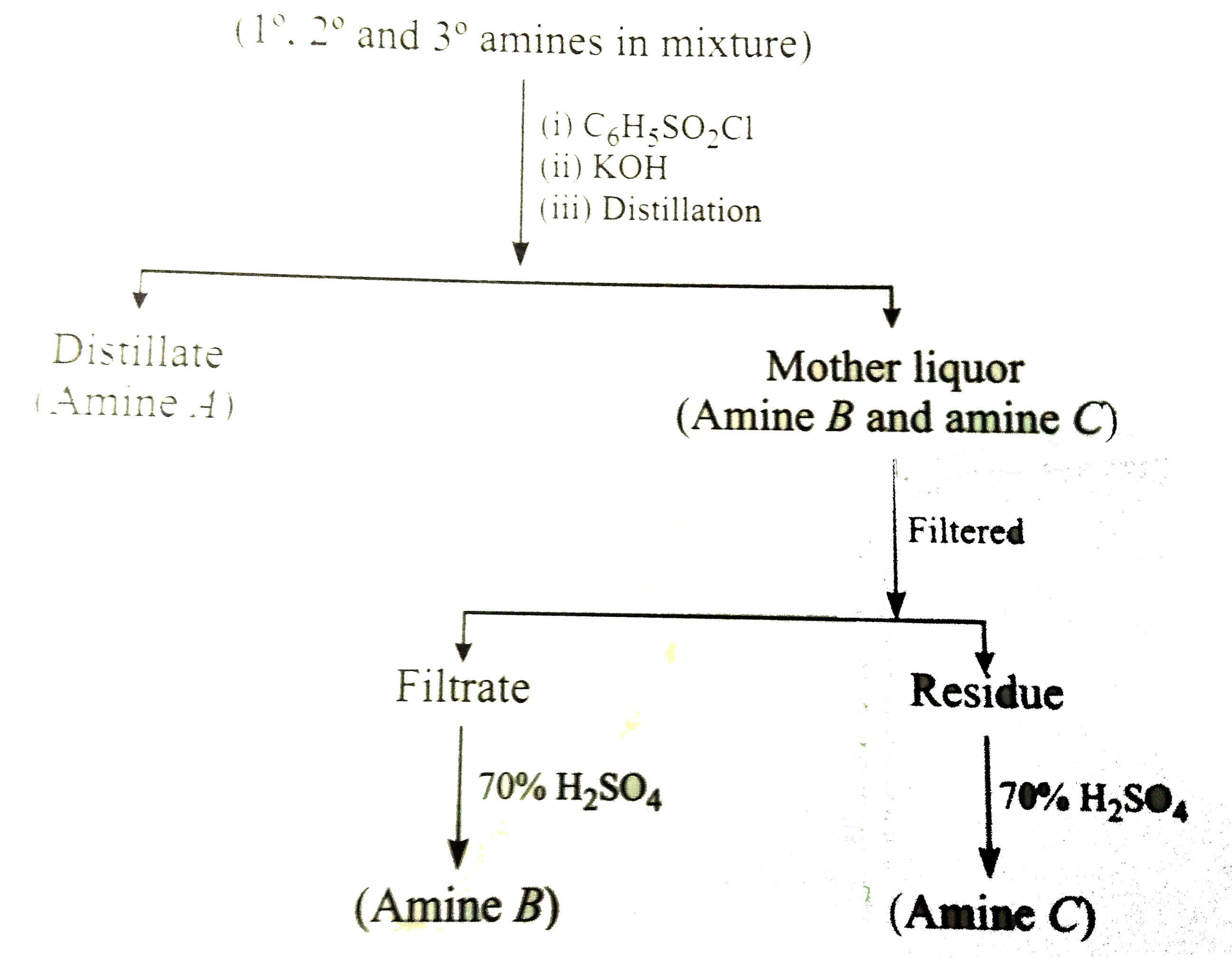A: 1∘,2∘ and 3∘ amines are separated by Hinsberg's method.
R: Hinsberg's reagent is C6H5SO2CI.
If both Assertion & Reason are true and the reason is the correct explanation of the assertion, then mark (1).
If both Assertion & Reason are true but the reason is not the correct explanation of the assertion, then mark (2)
If Assertion is true statement but Reason is false, then mark (3)
If both Assertion and Reason are false statements, then mark (4)
The correct Answer is:2
To solve the assertion-reason question regarding the separation of amines using Hinsberg's method, we can break it down into the following steps:
1. Understanding the Assertion:
The assertion states that primary, secondary, and tertiary amines can be separated using Hinsberg's method. This is true because Hinsberg's method is specifically designed to distinguish between these types of amines based on their reactivity with Hinsberg's reagent.
Hint: Recall the definitions of primary, secondary, and tertiary amines and their reactivity.
2. Identifying Hinsberg's Reagent:
The reason states that Hinsberg's reagent is benzene sulfonyl chloride (C₆H₅SO₂Cl). This is also true, as benzene sulfonyl chloride is the reagent used in the Hinsberg method to react with amines.
Hint: Familiarize yourself with the structure and formula of benzene sulfonyl chloride.
3. Reactions of Amines with Hinsberg's Reagent:
- Primary Amines: When a primary amine reacts with benzene sulfonyl chloride, it forms a sulfonamide that is soluble in NaOH.
- Secondary Amines: A secondary amine will also react with the reagent to form a sulfonamide, but this product is not soluble in NaOH.
- Tertiary Amines: Tertiary amines do not react with benzene sulfonyl chloride to form a sulfonamide, hence they remain unreacted.
Hint: Understand the solubility differences of the products formed from primary, secondary, and tertiary amines when treated with NaOH.
4. Evaluating the Reason as an Explanation:
While both the assertion and reason are true, the reason provided does not fully explain why the assertion is true. The reason should have included details about the solubility of the sulfonamides formed from primary and secondary amines and the lack of reaction for tertiary amines.
Hint: Consider what makes a good explanation and whether the reason addresses the core of the assertion.
5. Conclusion:
Since both statements are true but the reason does not adequately explain the assertion, the correct conclusion is that the assertion is true, the reason is true, but the reason is not the correct explanation of the assertion.
Final Answer: Assertion (A) is true, Reason (R) is true, but R is not the correct explanation of A.
The assertion states that primary, secondary, and tertiary amines can be separated using Hinsberg's method. This is true because Hinsberg's method is specifically designed to distinguish between these types of amines based on their reactivity with Hinsberg's reagent.
The reason states that Hinsberg's reagent is benzene sulfonyl chloride (C₆H₅SO₂Cl). This is also true, as benzene sulfonyl chloride is the reagent used in the Hinsberg method to react with amines.
- Primary Amines: When a primary amine reacts with benzene sulfonyl chloride, it forms a sulfonamide that is soluble in NaOH.
- Secondary Amines: A secondary amine will also react with the reagent to form a sulfonamide, but this product is not soluble in NaOH.
- Tertiary Amines: Tertiary amines do not react with benzene sulfonyl chloride to form a sulfonamide, hence they remain unreacted.
While both the assertion and reason are true, the reason provided does not fully explain why the assertion is true. The reason should have included details about the solubility of the sulfonamides formed from primary and secondary amines and the lack of reaction for tertiary amines.
Since both statements are true but the reason does not adequately explain the assertion, the correct conclusion is that the assertion is true, the reason is true, but the reason is not the correct explanation of the assertion.
Similar Questions
Knowledge Check
10,20,30 amines can be distinguish by Hinsberg's reagent Hinsberg's reagent is
AAcetic unhydrideBAcetyl chlorideCNitrous acidDBenzene sulphonyl chlorideA mixture of 1∘,2∘ and 3∘ amines can be separated by Hinsberg's reagent which is
ABenzoyl chlorideBAcetyl chlorideCBenzene sulphonyl chlorideDBenzyl chlorideA mixture of 1∘,2∘ and 3∘ amines can be separated by Hinsberg's reagent which is
ABenzoyl chlorideBacetyl chlorideCbenzene sulphonyl chlorideDbenzyl chloride.
a. Distinguish between 1∘,2∘, and 3∘ amines by using succine anhydride (A).
b. What are the limitations of Hinsberg reagent?
c. Give the structural formula of a chiral compound C8H11N(X), which dissolves in dilute HCl and evolves N2 gas with HNO2.
View Solution3∘ amines with Hinsberg's reagent give
View SolutionEANof[Feη2−C5H5)(CO)2CI]:
View SolutionBenzene sulphonyl chloride (C6H5SO2Cl) is called Hinsberg's reagent. It is used for the distinction between primary, secondary and teriary amines. It is also used for separation of primary, secondary and teritiary amines from their mixture. (1∘,2∘,3∘ amines in mixture)

The resisdue insoluble in KOH obtained in the Hinsberg's test, corresponds to:
View SolutionWhich of the following reagents is used for the Hinsberg method to separate amines ? .
View Solution

